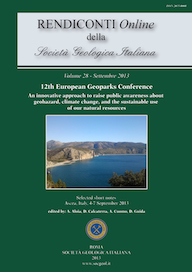
The public opinion of the teachers about the mineral exploitation in São José de Itaboraí Basin – Itaboraí (Rio de Janeiro State, Brazil)
Wellington Francisco Sá dos Santos (*) & Ismar de Souza Carvalho (*)
(*) Universidade Federal do Rio de Janeiro, Centro de Ciências Matemáticas e da Natureza, Instituto de Geociências, Departamento de Geologia. Av. Athos da Silveira Ramos, 274. Bloco F. 21941-916. Cidade Universitária, Ilha do Fundão, Rio de Janeiro, Brazil. E-mail: wfsasantos@gmail.com; ismar@geologia.ufrj.br
Volume: 28/2013
Pages: 133-136
Abstract
The mining of limestone had positive and negative effects on the 6th district of Itaboraí (Rio de Janeiro State). During the time of mining activity by the National Company of Portland Cement "Mauá" (1933 to 1984) several invertebrate and vertebrate fossils, especially mammals from the Late Paleocene (57 Ma) were discovered in São José de Itaboraí Basin. Mineral exploitation contributed to creating jobs and improving the infrastructure of the region. However, with the end of the activity, the area entered in a process of socioeconomic decay. To establish geosite geoconservation, the São José de Itaboraí Paleontological Park was created in 1995. The institution is currently going through a revitalization process, which includes the construction of a cultural center for the protection of fossiliferous collections and scientific exposition. These initiatives can result in social and economic development of neighborhoods near the paleontological park through the intensification of geotouristic activity. In this context, interviews were conducted with teachers around the paleontological park, to seek their public opinion on relation to the mineral exploitation.
Keywords
Get Full Text